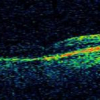Free Online Productivity Tools
i2Speak
i2Symbol
i2OCR
iTex2Img
iWeb2Print
iWeb2Shot
i2Type
iPdf2Split
iPdf2Merge
i2Bopomofo
i2Arabic
i2Style
i2Image
i2PDF
iLatex2Rtf
Sci2ools
ISBI
2008
IEEE
2008
IEEE
Local quality assessment for optical coherence tomography
Optical Coherence Tomography (OCT) is a non-invasive tool for visualizing the retina. It is increasingly used to diagnose eye diseases such as glaucoma and diabetic maculopathy. However, diagnosis is only possible when the layers of the retina can be easily distinguished, which is when the images are evenly illuminated. Automated OCT quality assessment (i.e. signal strength) is only available for images as a whole. In this work, we present an automated method for local quality assessment. For training data, three OCT experts label the quality of each individual a-scan line in 270 OCT images. We extract features that are insensitive to pathology, and employ a hierarchy of support vector machines and histogram-based metrics. Our trained classifier is able to determine not only when signal strength is low, but also when it will affect doctors' diagnostic ability. Our results improve over the state of the art in OCT quality assessment.
| Added | 20 Nov 2009 |
| Updated | 20 Nov 2009 |
| Type | Conference |
| Year | 2008 |
| Where | ISBI |
| Authors | Gadi Wollstein, Hiroshi Ishikawa 0002, Joel Schuman, Mei Chen, Peter Barnum |
Comments (0)

